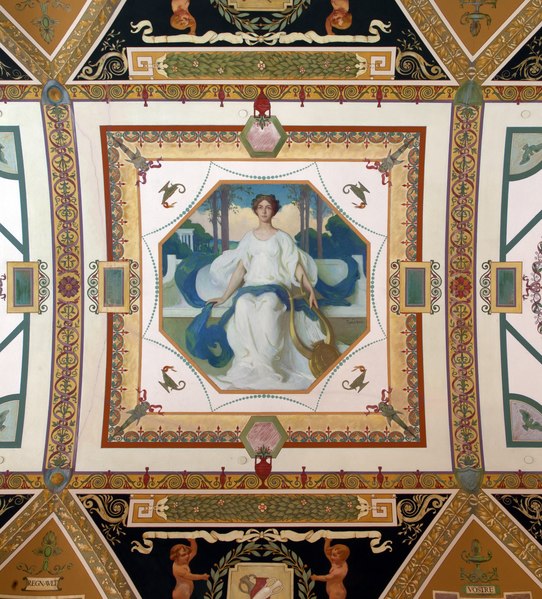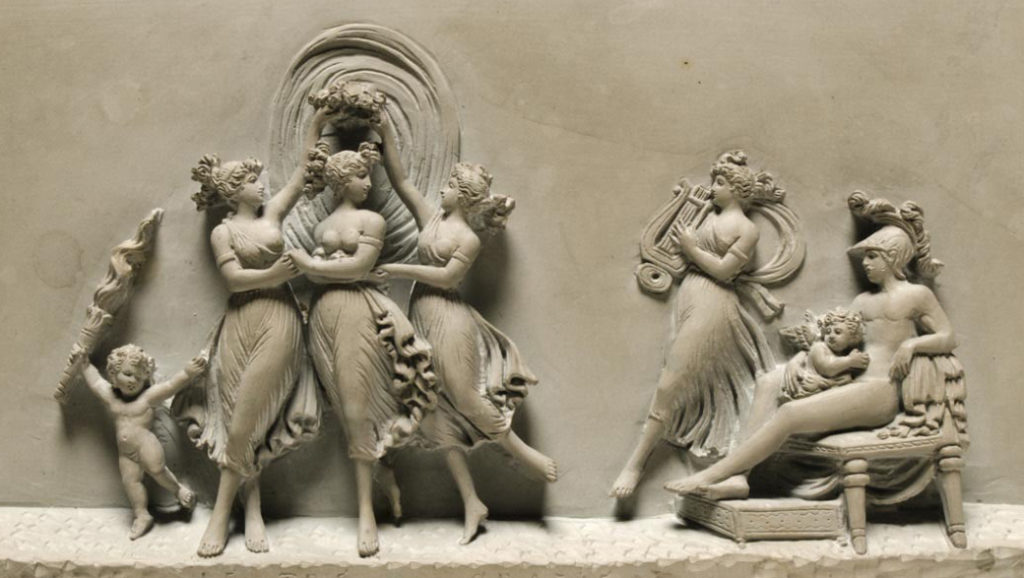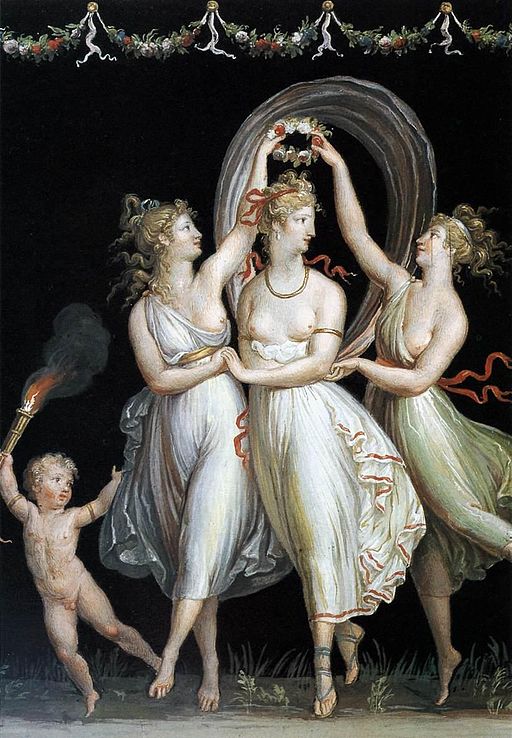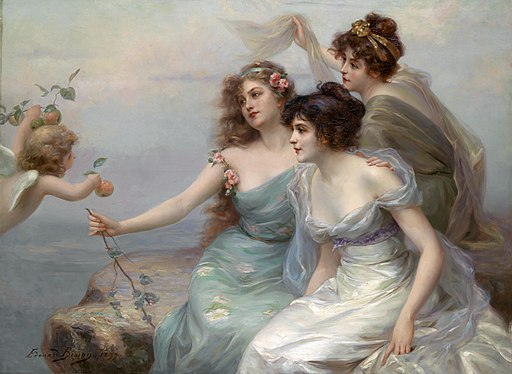2021.03.06 | By Gregory Nagy
§0. The three ‘Graces’ or Khárites, personifications of kháris, a noun often translated in a generalizing way as ‘grace’, are reverently addressed in a victory ode of Pindar, Olympian 14, as presiding goddesses of the city of Orkhomenos in Boeotia, named Erkhomenós (feminine gender) in the local dialect (Ἐρχομενοῦ, line 3). A young man named Asōpikhos (line 17), a native son of this city, is the victorious athlete whose Olympian victory is celebrated in Pindar’s ode, and he is figured in the song as a special protégé of the three goddesses presiding over Orkhomenos, who are literally the basíleiai or ‘queens’ of this city (line 3). The supreme status of the three Khárites or ‘Graces’ (line 4) of Orkhomenos is affirmed by their genealogy: these goddesses are children of Zeus himself (lines 12, 14–15). Also, the city over which they preside is their own ‘seat-of-honor’ (hédrā, line 2), and, as ‘presiders’, they are entitled to pre-eminent seating (I note the word thronoi at line 11) right next to another pre-eminent child of Zeus, the god Apollo himself (lines 10–11). These three queenly goddesses are named, and I transliterate their names here as we find them articulated in the blended Doric-Aeolic dialect of Pindaric diction: Aglaíā (Ἀγλαΐα), Euphrosúnā (Εὐφροϲύνα), and Thalíā (Θαλία) at lines 13, 14, and 15 of Pindar’s song. The name of one of these ‘Graces’, Thalia, is also attested as the name of one of the nine Muses as we find them listed in the Hesiodic Theogony, lines 77–79. The name of that other Thalia, listed at line 77 as the third of the nine Muses, is articulated as Tháleia (Θάλεια) in the Ionian poetic dialect of Hesiodic diction. In what follows, I will argue that the convergence of identities for this goddess Thalia, as both ‘Grace’ and ‘Muse’, reveals an old pattern of poetic celebration that goes back to an era when ‘Graces’ and ‘Muses’ were as yet undifferentiated. Or, to put it another way, the three Graces were once upon a time just as ‘musical’ as the Muses themselves.

§1. The ‘musical’ nature of the Graces is evident, right from the start, in the way they are situated by Pindar’s words. As divine queens of Orkhomenos, they share the royal seat of honor with the divine Apollo, who is universally recognized in Pindar’s era as the leader of the Muses in the choral singing and dancing of thοse goddesses. When I say ‘choral’ here and everywhere else, I mean of course the dancing as well as the singing that traditionally takes place in ancient Greek choral performance as signaled by the word khorós, which means ‘group of singers-and-dancers’, unlike chorus in English and in other modern languages that have restricted the semantic range of this imported ancient word to mean, more simply, ‘group of singers’. And the ‘musical’ role of the Graces as an idealized group of singers-and-dancers is made explicit in Pindar’s Olympian 14, where the choral singing-and-dancing of the gods themselves, who are the idealizing models for all choral performance, is actually regulated by the three Graces: as we read in the words of Pindar (lines 7–8): οὐδὲ γὰρ θεοὶ ϲεμνᾶν Χαρίτων ἄτερ | κοιρανέοντι χορούϲ ‘not even the gods can do without the sacred Graces [Khárites] in presiding-over ensembles of song-and-dance [khoroí]’. For more on singing and dancing by the gods themselves as an idealized model for human choral performance, I cite a most telling expression, θείου χοροῦ, in Plato Phaedrus 247a; commentary in Nagy PasP p. 56).

§2. The choral nature of the Muses as an idealized ensemble of singers-dancers is evident in their “speaking-names”: as we review the Hesiodic grouping of nine Muses in the Theogony, for example, the names Melpoménē (Μελπομένη) at line 77 and Terpsikhórē (Τερψιχόρη) at line 78 stand out. From what we have already seen about the semantics of khorós, the meaning of Terpsikhórē is obvious: her speaking name means ‘she who gets/gives pleasure by way of khoroí’. In the case of Melpoménē, the meaning is less obvious, until we consider the fact that the verb mélpein (also middle voice mélpesthai) means not simply ‘sing’, as it is sometimes translated, but rather ‘sing-and-dance-in-a-khorós’ (Nagy MoM 4§15; PH 12§29 p. 350 and p. 351n64; also HC 2§75). These names of two of the Muses are relevant to the epithets that describe two of the Graces in Pindar’s Olympian 14: Euphrosúnā (Εὐφροϲύνα) is addressed as philēsí-molpos (φιληϲίμολπε) ‘lover of song-and-dance’ at line 14 while Thalíā (Θαλία) is addressed as erasí-molpos (ἐραϲίμολπε) ‘aroused with desire for song-and-dance’ at line 16.
§3. These epithets of the Graces show that these goddesses are choral personalities, just like the Muses. And even the poet of Olympian 14, Pindar himself, refers to himself here as a choral personality in his own right. In his persona as a praise-poet—who is the “laudator”—he prays especially to the Third Grace, called Thalia, to look favorably at the kômos or ‘ensemble of revelers’ that is celebrating the victorious athlete who must be praised—who is the “laudandus” —and, in so praying, the poet describes this ensemble of celebrating revelers or kômos as ‘stepping lightly’, that is, dancing gracefully, while the poet describes his own role as ‘singing’, having personally arrived to participate in a choral celebration. This celebration is pictured as singing and dancing by the whole ensemble, since the overall performance is supervised by Thalia herself as a choral personality. I quote the words of Pindar (lines 15–18): Θαλία τε | ἐραϲίμολπε, ἰδοῖϲα τόνδε κῶμον ἐπ᾿ εὐμενεῖ τύχᾳ | κοῦφα βιβῶντα· Λυδῷ γὰρ Ἀϲώπιχον ἐν τρόπῳ | ἐν μελέταιϲ τ᾿ ἀείδων ἔμολον ‘and [I invoke you too to hear my prayer,] you, O Thalia, aroused with desire for song-and-dance, looking upon this ensemble-of-revelers [kômos] stepping lightly, in response to genuinely powerful fortune. The song of Asōpikhos, practicing it in the Lydian mode, singing it, I have arrived.’
§4. In the victory odes of Pindar, as also of Bacchylides, the choral singing-and-dancing of male revelers celebrating the athletic victory of a comrade is conventionally expressed by way of the word kômos, but the model for such celebration is the choral singing-and-dancing of beautiful goddesses, and their ensemble is described in wording that overtly pictures a khorós—as here in Pindar’s Olympian 14, line 8. I find a comparable example in Ode 13 of Bacchylides, where the verb mélpein at line 94 and also later, at line 190, refers to the choral singing and dancing of local nymphs whose performance is pictured as an idealized model for the choral singing and dancing of male revelers, expressed by way of the word kômos at line 74 (Nagy 2011:186–187).
§5. The choral role of the three Graces in Pindar’s Olympian 14 is grounded, as we see from the diction of the poet, in festivities that mark the celebration of festivals as marked especially by the merriment of feasts, that is, where celebrants feast merrily on food and drink—to the accompaniment of song and dance, of course. I highlight here the third of the three “F-s” of festivities, festivals, and feasts, as conveyed by the word daís in Odyssey 8.429, as I analyzed it at length in another work (HPC I§§191–241). I noted, in my analysis there, that the setting for all the feasting described in Odyssey 8 is connected with a primal ‘feast [daís] of the gods’ that is mentioned at Odyssey 8.76, theôn en daitì thaleíēi (θεῶν ἐν δαιτὶ θαλείῃ). The epithet tháleia here, describing a primal daís ‘feast’, is also used to describe the ongoing daís or ‘feasting’ narrated in Odyssey 8 and signaled at line 99 of that narration, daitì…. thaleíēi (δαιτὶ … θαλείῃ). This epithet tháleia is of special interest in light of the meaning of the noun thalíai in the plural, ‘festivities’, as in Odyssey 11.603. So, how do we translate this epithet tháleia? For an answer, I look back at the name of the Third Grace, Thalia, and I quote a relevant passage again from Olympian 14, but, this time, I show two additional words in the original Greek text. As we read in the words of Pindar (lines 7–9): οὐδὲ γὰρ θεοὶ ϲεμνᾶν Χαρίτων ἄτερ | κοιρανέοντι χοροὺϲ | οὔτε δαῖταϲ ‘not even the gods can do without the sacred Graces [Khárites] in presiding-over ensembles of song-and-dance [khoroí]—or feasts [daîtes]’. The correlation here of choral performance with feasting shows clearly the holistic essence of Thalia the goddess. She makes Earth ‘flourish’—that is what the verb thállein means, ‘flourish’, and the epithet tháleia means ‘flourishing’.
§6. This epithet tháleia can apply to a daís or a ‘feast’ the same way that the goddess Thalia, who promotes such flourishing, is worshipped together with her sister Graces as the embodiment of festive choral singing-and-dancing that celebrates the flourishing of Mother Earth—such as the mother earth that is Orkhomenos in Boeotia. These Graces are the distributors of bounty, and ‘distribution’ is after all the fundamental meaning of the noun for feasting, daís. That is why the Graces are the tamíai or ‘distributors’ of all good things that are heaven-sent. As the wording of Pindar describes them at line 9–10, the Graces are πάντων ταμίαι | ἔργων ἐν οὐρανῷ, ‘apportioners [tamíai] of all things that are done in the heavens’.
§7. Thus the Graces can join the Muses in grand choral celebrations of new fertility. That is why these goddesses, together with the Muses, celebrate the wedding of Kadmos and Harmonia, as we read in Theognis 15–18—a happy event that marks the foundation of the city of Thebes in Boeotia (Nagy 1985:27–29; GMP 275).
§8. The beauty and the pleasure of such celebrations, and here I return to Pindar’s Olympian 14, is embodied in the names of the two other Graces, Aglaíā and Euphrosúnā. The ‘splendor’ of Aglaíā and the ‘merriment’ of Euphrosúnā are programmatic markers of such beauty and pleasure. In the case of euphrosúnē, this word can even mark the occasion of happily celebrating any victory ode, as noted by Elroy Bundy (1986:2; further commentary by Nagy BA 5§39 p. 91, 12§15 p. 236; also PH 6§92 p. 198 and GMP 271).
§9.Thanks to the personified Khárites, I can finally be more specific in translating kháris as not merely ‘grace’ but also, more specifically, as referring to both the beauty and the pleasure of social exchange. The semantics of the Latin analogue of kháris, which is gratia, can help us see this all more clearly—by way of such English-language imports as graceful and gratifying.
§10. The kháris—the beauty and the pleasure—that radiates from the three Graces is already noted in the Hesiodic Theogony, lines 907–911, where these goddesses are identified as separate from the Muses, listed earlier at lines 77–79. The Graces, identified as Khárites at line 907 (Χάριτας, in the accusative), are named in the Ionic dialect at line 909: Aglaíē, Euphrosúnē, and Thalíē (Ἀγλαΐην / Εὐφροσύνη / Θαλίην, all in the accusative), and their relationship to any particular locale, as in the case of Orkhomenos in Boeotia, is shaded over in the Hesiodic description. What is highighted, by contrast, is the eroticism, lovingly described at lines 910–911, of the beauty and the pleasure embodied by these three personifications of kháris. Correspondingly, as we read in scholia for the Hesiodic Theogony (p. 373 ed. Flach 1876), ancient painters delighted in sensuously painting these goddesses as ‘naked and holding on to each other’ (γυμνὰς ἐχομένας ἀλλήλων). In the scholiastic tradition, such a picturing of the three Graces could be read allegorically, where the question is whether kháris as a ‘favor’ is freely granted or whether it is granted only by obligation for a favor previously granted (again I cite the same page of Hesiodic scholia edited by Flach). But of course the gesture of holding on to each other transcends whatever favors are or are not freely granted. To hold on to each other is what you do in choral dance, and, at least to such an extent, the choral identity of the three Graces was preserved in the ancient visual arts—and lovingly perpetuated by artists ever since, maybe with misunderstandings of favors freely or not freely granted.




Bibliographical Abbreviations
BA = Best of the Achaeans, Nagy 1979/1999.
GMP = Greek Mythology and Poetics, Nagy 1990b.
H24H = The Ancient Greek Hero in 24 Hours, Nagy 2013
HC = Homer the Classic, Nagy 2009|2008
HPC = Homer the Preclassic, Nagy 2010|2009
HQ = Homeric Questions, Nagy 1996b
HR = Homeric Responses, Nagy 2003
LSJ = Liddell, H. G., R. Scott, and H. S. Jones. 1940. A Greek-English Lexicon. 9th ed. Oxford.
MoM = Masterpieces of Metonymy, Nagy 2016|2015
PasP = Poetry as Performance, Nagy 1996a
PH = Pindar’s Homer, Nagy 1990a
Bibliography
Bundy, E. L. 1986 [1962]. Studia Pindarica. Berkeley / Los Angeles.
Flach, H., ed. 1876. Glossen und Scholien zur hesiodischen Theogonie. Leipzig.
Muellner, L. 1976. The Meaning of Homeric EYXOMAI through its Formulas. Innsbruck. http://nrs.harvard.edu/urn-3:hul.ebook:CHS_MuellnerL.The_Meaning_of_Homeric_eukhomai.1976.
Nagy, G. 1979/1999. The Best of the Achaeans: Concepts of the Hero in chaic Greek Poetry. Baltimore. Revised ed. with new introduction 1999. http://nrs.harvard.edu/urn-3:hul.ebook:CHS_Nagy.Best_of_the_Achaeans.1999.
Nagy, G. 1985. “Theognis and Megara: A Poet’s Vision of His City.” Theognis of Megara: Poetry and the Polis, ed. T. J. Figueira and G. Nagy, 22–81. Baltimore. http://nrs.harvard.edu/urn-3:hlnc.essay:Nagy.Theognis_and_Megara.1985. Corrigenda: at §77, “Pausanias 1.5.3 should be “Pausanias 1.5.4.”
Nagy, G. 1990a. Pindar’s Homer: The Lyric Possession of an Epic Past. Baltimore. http://nrs.harvard.edu/urn-3:hul.ebook:CHS_Nagy.Pindars_Homer.1990.
Nagy, G. 1990b. Greek Mythology and Poetics. Ithaca, NY. Revised paperback edition 1992. http://nrs.harvard.edu/urn-3:hul.ebook:CHS_Nagy.Greek_Mythology_and_Poetics.1990.
Nagy, G. 1994. “Genre and Occasion.” Mètis: Anthropologie des mondes grecs anciens 9–10:11–25. http://nrs.harvard.edu/urn-3:hlnc.essay:Nagy.Genre_and_Occasion.1994.
Nagy, G. 1996a. Poetry as Performance: Homer and Beyond. Cambridge. http://nrs.harvard.edu/urn-3:hul.ebook:CHS_Nagy.Poetry_as_Performance.1996.
Nagy, G. 1996b. Homeric Questions. Austin. http://nrs.harvard.edu/urn-3:hul.ebook:CHS_Nagy.Homeric_Questions.1996.
Nagy, G. 1999. See Nagy 1979.
Nagy, G. 2009|2008. Homer the Classic. Printed | Online version. Hellenic Studies 36. Cambridge, MA, and Washington, DC. http://nrs.harvard.edu/urn-3:hul.ebook:CHS_Nagy.Homer_the_Classic.2008.
Nagy, G. 2010|2009. Homer the Preclassic. Printed | Online version. Berkeley and Los Angeles. http://nrs.harvard.edu/urn-3:hul.ebook:CHS_Nagy.Homer_the_Preclassic.2009.
Nagy, G. 2011c. “A Second Look at the Poetics of Reenactment in Ode 13 of Bacchylides.” Archaic and Classical Choral Song: Performance, Politics and Dissemination, ed. L. Athanassaki and E. L. Bowie, 173–206. Berlin. http://nrs.harvard.edu/urn-3:hlnc.essay:Nagy.A_Second_Look_at_the_Poetics_of_Re-Enactment.2011.
Nagy, G. 2013. The Ancient Greek Hero in 24 Hours. Cambridge, MA. http://nrs.harvard.edu/urn-3:hul.ebook:CHS_NagyG.The_Ancient_Greek_Hero_in_24_Hours.2013.
Nagy, G. 2016|2015. Masterpieces of Metonymy: From Ancient Greek Times to Now. Hellenic Studies 72. Cambridge, MA, and Washington, DC. http://nrs.harvard.edu/urn-3:hul.ebook:CHS_Nagy.Masterpieces_of_Metonymy.2015.
